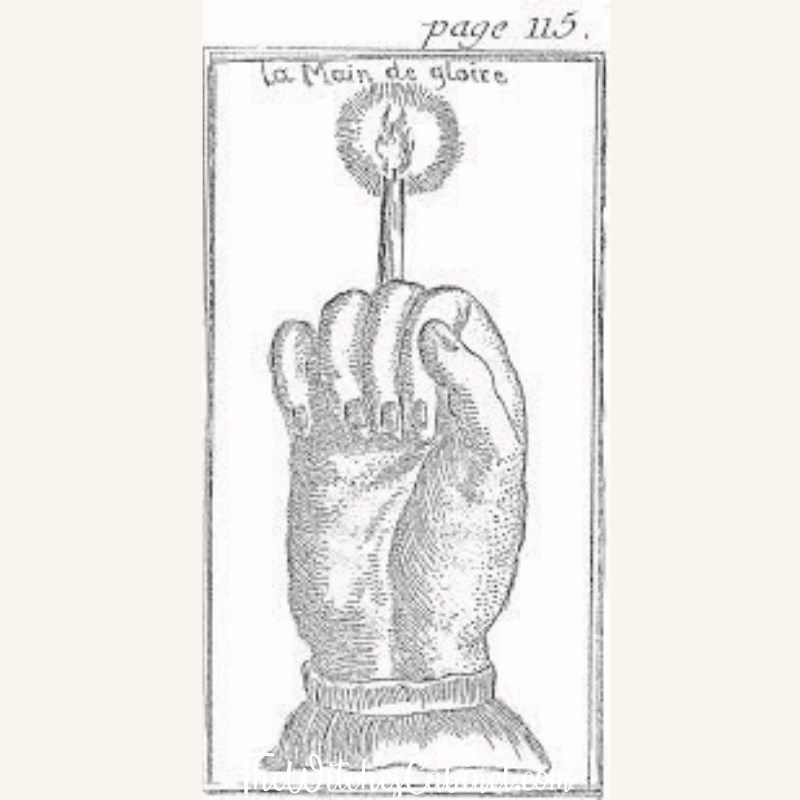Witchcraft isn’t always pretty. Sometimes it’s downright disturbing. Yet even those disturbing ingredients and anecdotes intrigue us. As human beings, many of us are drawn to the taboo, whether we admit it or not. The hand of glory offers a hand-out of nightmares, folklore, and inspiration for those who dare take it. Learn all about its origins, history, and properties here.
What is the Hand of Glory?
First, we must define the infamous Hand of Glory. Put simply, the Hand of Glory is the pickled hand of a hanged man that holds a candle and is used for nefarious magical purposes. The concept likely originates in the early Modern period, but may have originated even earlier in the Medieval Times. Some scholars believe the Hand of Glory wasn’t a real thing per se, but another method of accusing someone of practicing witchcraft.
So the Hand of Glory was made by acquiring the left hand (or the hand that did the crime) from a hanged criminal – typically it was the hand of a murderer or thief. But I believe accused and executed witches’ hands were also used. Think of it this way – the more powerful the person, the more potent the Hand of Glory. And, since the Hand of Glory was considered magical, what would make it more magical than the hand of someone who practiced magic?
Some believe the name Hand of Glory is a false derivative of the French term main de glore, which translates to mandragore or mandrake. If we examine the history of the mandrake plant, we see many references to the root being used as a familiar spirit. In Germany, the mandrake is a familiar that’s called the Alraun, and often kept by families as a guardian and to bring good luck to the household. Perhaps there is a connection between the two, but in my opinion, the only real connection is in name. The mandrake root doesn’t look like a hand, it looks more like a small man. Read more about mandrake magic here.
The Hand of Glory’s Powers and Modern Magical Abilities
According to the Grimoire Petit Albert written in 1722, the Hand of Glory’s main attribute was that it rendered people motionless. It literally made them freeze in their tracks. Another of its powers was to be able to break through any lock on any door and give its maker access to any building. Imagine this – a man breaks into your home in the middle of the night carrying a dried skeletal hand that’s accompanied by a lit taper candle. I’m pretty sure I would be rendered motionless, as well. So perhaps the magic was in the terror, after all. And guess what kind of person would make a Hand of Glory in order to break through locks and render people motionless? Yeah, a criminal. A thief, more than likely.
When we think about what the magical correspondences of the hand might be in modern witchcraft (whether by itself or still attached), we have the following: grasping at power and abundance, strength, directing energy towards things, taking things away, holding hands = love and friendship, reading one’s palms to determine the future, and remember many witches and magicians use their hands as natural wands. And, as we’ll soon see, the hand is also used to shake hands in making pacts, deals, and even just greeting friends and relatives. Therefore, the Hand of Glory in modern times might be useful in coven initiation ceremonies or magical pacts between familiar spirits and witches.
For Making Dark Pacts
Also pulled from AE Waite’s Book of Ceremonial Magic, we see the Hand of Glory mentioned again in relation to making dark pacts with spirits and performing black magic:
“Such persons, it is affirmed, will never succeed in evoking spirits unless they perform, point by point, all that is detailed hereinafter concerning the manner of making pacts with any spirit whatsoever, whether the object in view may be the possession of treasures concealed in the earth, the enjoyment of women or girls, and for obtaining any desired favour at their hands, whether for the discovery of the most hidden secrets in all Courts and Cabinets of the world, whether for the revelation of the most impenetrable mysteries,
whether for engaging a spirit to perform one’s work in the night, whether to cause a fall of hail or a storm in any appointed place, whether to open seals, to behold what is passing in private houses and learn all the skill of the shepherds, whether to obtain the Hand of Glory and discern all the qualities and virtues of metals, minerals and vegetables, of animals both pure and impure, and “to perform things so astounding that no person in existence can fail to be in a condition of utter bewilderment on seeing that by means of a pact with certain spirits one can discover the grandest secrets of Nature, which are hidden from the eyes of all other men.”

The Hand of Fortune and the Hand of Glory
While there’s no true correlation between these two symbols and tools, I can’t help but notice a resemblance between the Hand of Fortune and the Hand of Glory. The Hand of Fortune is an ancient talisman, likely dating back to prehistoric times, and is a symbol that’s been found on ancient Libyan and Phoenician tombs, as well as in ancient Celtic dig sites. The Hand of Fortune is a symbol of an open hand and sometimes a white handprint. The power it holds is one of warding – protection from evil spirits and misfortunes. This magical hand was typically placed over or on thresholds to bar any evil from entering a home or building.
And, again, we see another similar symbol in the Hand of Fatima, also called the Hamsa. This is the image of an open hand with the all-seeing eye on the palm. This protective amulet is traced to ancient Mesopotamia and is still in use all over the world today. Does the Hamsa or Hand of Fortune have anything to do with the Hand of Glory? It’s possible the Hand of Glory was a “bite” off the many Hand symbols and amulets used throughout history. Or it could have been a sort of play off the power of this symbol.
How is the Hand of Glory Made?
Obviously one must acquire the hand of a hanged man, preferably a criminal of some kind. It should be the left hand or the hand that committed the evil deed. According to the Book of Ceremonial Magic by AE Waite (yes the same guy who helped craft the Rider-Waite Tarot Deck), the hanged person’s hand should be gathered in a winding sheet, the blood squeezed from it, and then put in an earthen vessel with zimort, salt petre, salt and peppercorns. Then it should be left to dry out in the dog days of Summer.
But don’t forget! Save the grease and whatever remnants from the hand itself to make the candle. This candle should be made with virgin wax and sesame from Lapland. Then the candle is placed between the fingers of the Hand of Glory OR the fat and wax can be molded around the fingers and the fingers used as candles instead. I should also note here that this information acquired and written by AE Waite was said to have been acquired by people who were on trial, who had confessed to these acts under torture. So we should take this with a grain of salt petre. Get it?
Anecdotes and Remedies to Ward off the Hand of Glory
There were ways of shielding oneself from the powers of the Hand of Glory, should someone try to use it on you or your family. Backtracking to AE Waite’s account, the occultist claims one can ward off the powers of the Hand by anointing their thresholds with a concoction of the gall of a black cat, the grease of a white fowl, and the blood of a screech owl. This grisly remedy should also be crafted during the dog days of Summer. To me, this seems to point to the idea of beating fire with fire. If the Hand of Glory is made in the dog days of Summer, so must the ward be.
I did some digging and found another resource that tells an interesting tale about the Hand of Glory. The book is called English Fairy and Other Folk Tales by Edwin Sidney Hartland written in 1890. Hartland tells a local tale about a girl who saved her entire household from an intruder’s demise. Somehow, she’s able to follow the thief and blow out the Hand of Glory’s candle. Then she uses milk and throws it over the doorknob to let herself out. Apparently the intruder thought he could render the entire household motionless and lock them away while he stole whatever he sought to steal. But, instead, he got a shock when the young woman was able to counteract his magic.
Note: only milk will put out the candle of the Hand of Glory, according to legend.
The Modern Hand of Glory and Candle Magic
If you’d like to see a legitimate historical hand of glory, you’ll have to visit the Whitby Museum in North Yorkshire, England. There is one on display along with a book that was published in the eighteen hundreds. That being said, we don’t recommend stealing the hand from a corpse, as it is entirely illegal. Plus, you’re defiling the dead, and we believe they will seek their vengeance on you and it won’t be pretty.
So, is there some way to practice magic with the Hand of Glory in modern times, or a modern replica of one? Absolutely! There’s a few ways you can go about this.
- You can purchase a “Hand of Glory” from the internet
- You can make a Hand of Glory with wax, clay, or some other moldable media and then add a candle to the hand or between the fingers
Honestly, I prefer to make my own out of clay and add my own candles. But Etsy has some pretty amazing options from folks who handmade this powerful tool. You can even choose a specific color Hand of Glory to match your intentions:
- White Hand of Glory for protection and purification
- Black Hand of Glory for warding, banishing, sealing, and malefic magic
- Red Hand of Glory for passion, success, commanding, and dominating
Don’t forget to cleanse and charge your Hand of Glory with whatever your intention is for this historical and bizarre witchcraft tool. We recommend smoke-cleansing it and then charging it in the moonlight before ritual use. After you burn it all the way down, wrap it in cloth and bury it…particularly if it was used for malefic purposes.











One thought on “Hand of Glory: Grisly History, Lore, and Modern Candle Magic”